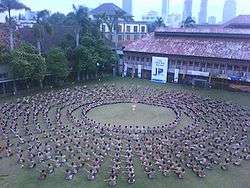Kecak
| Kecak |
|---|
 |
|
| Burma |
| Cambodia |
| Indonesia |
| Laos |
| Malaysia |
| Philippines |
| Thailand |
| Vietnam |
Kecak (pronounced [ˈketʃaʔ], alternate spellings: Ketjak and Ketjack) is a form of Balinese dance and music drama that was developed in the 1930s in Bali, Indonesia. Since its creation, it has been performed primarily by men, with the very first women's kecak group starting in 2006.[1]
Also known as the Ramayana Monkey Chant, the piece, performed by a circle of at least 150 performers wearing checked cloth around their waists, percussively chanting "cak" and moving their hands and arms, depicts a battle from the Ramayana. The monkey-like Vanara led by Hanuman helped Prince Rama fight the evil King Ravana. Kecak has roots in sanghyang, a trance-inducing exorcism dance.[2]
History
Kecak was originally a trance ritual accompanied by male chorus. In the 1930s, Walter Spies, a German painter and musician, became deeply interested in the ritual while living in Bali. He adapted it as a drama, based on the Hindu Ramayana and including dance, intended for performance before Western tourist audiences.
This is an example of what James Clifford describes as part of the "modern art-culture system"[3] in which, "the West or the central power adopts, transforms, and consumes non-Western or peripheral cultural elements, while making 'art,' which was once embedded in the culture as a whole, into a separate entity."[4] Spies worked with Wayan Limbak, who popularized the dance by arranging for performances by Balinese groups touring internationally. These tours have helped make the kecak internationally known.
| Music of Indonesia | |
|---|---|
 Kempul gongs from Java | |
| |
| Genres | |
| |
| Specific forms | |
| Regional music | |

I Wayan Dibia, a performer, choreographer, and scholar, suggests, by contrast, that the Balinese were already developing this form when Spies arrived on the island.[5] For example, during the 1920s, the well-known dancer I Limbak had incorporated Baris movements into the cak leader role. "Spies liked this innovation," and he suggested that Limbak "devise a spectacle based on the Ramayana," accompanied by cak chorus rather than gamelan, as would have been usual.[2]
In popular culture
- A kecak chant can be heard in the 1969 film Fellini Satyricon.
- The 1971 version of Kenneth Anger's Rabbit's Moon incorporates Kecak into the soundtrack.
- The 1982 Japanese Metal Hero Series, Space Sheriff Gavan episode 6: "The Geniuses of the Makuu School" uses Kecak chanting sample to emphasize a mystical atmosphere when the Beast-Alien Doubleman plays his magic flute and affected school students hypnotized by its sound unconsciously commanded to attack Gavan.
- The soundtrack to the Coen Brothers' 1984 debut film Blood Simple includes a track entitled "Monkey Chant" which is based on kecak.
- Dagger of Kamui (Kamui no Ken) (1985), an anime film, incorporates kecak in its score, often in action scenes involving shinobi.
- Kecak chanting is incorporated into the soundtrack for the Japanese animated film Akira (1988), which also features the Indonesian gamelan.
- A sample of Kecak chanting is in "The Wind Chimes," from Mike Oldfield's 1987 album Islands.
- The Indonesian song "Kembalikan Baliku" written by Guruh Sukarnoputra and performed by Yopie Latul for World Popular Song Festival 1987 in Tokyo, Japan, incorporates Kecak chanting in the interlude part performed by backing vocals. At the same time the song received Kawakami Audience Selection Award (ASA).[6][7]
- The San Francisco art rock band Oxbow's songs "Daughter" and "Daughter Bent & Floating" from their 1991 album King of the Jews, incorporates Kecak-inspired polyrhythmic chanting and clapping.
- Kecak is heard in I Never Promised You a Rose Garden, during fantasy sequences taking place in the heroine's paracosm.
- Footage of a kecak performance is featured in Ron Fricke's film Baraka (1992).
- A Kecak-style dance and chant can be seen in the fantasy portion of Tarsem Singh's film The Fall (2006).
- John Adams' opera, A Flowering Tree (2006), features Kumudha and the beggar minstrels in Act II, which are based on the Kecak. (per Cincinnati Opera pre-performance interview with the composer, 30 June 2011.)
- Mike Patton performs a Kecak-like chant in the song "Goodbye Sober Day" on the 1999 Mr. Bungle album California.
- A sample of Kecak chanting can be heard in the song "Soldier of Fortune" from Manhattan Transfer's album Bodies and Souls.
- A sample of Kecak chanting can be heard in the Nurse With Wound track "I Am Blind" from the album Homotopy to Marie.
- A sample of Kecak chanting mixed with Bali's Gamelan can be heard in the SNK Neo Geo arcade video game, "The King of Fighters '97" when the gameplay shows Bali arena scene. The arena also includes background animation of Kecak chanters on the right side, Barong dance on the center, and Gamelan performers with crowded audience on the left side.
- David Attenborough's 1969 BBC documentary, The Miracle of Bali, on the arts in Bali, featured the kecak in the 1st and 3rd episodes.
- Ketjak is a book-length poem by Ron Silliman published in 1978 and reprinted in The Age of Huts (2007), in which the author gives the title "Ketjak" to a vast ongoing cycle of works which includes Tjanting (1980) and The Alphabet (2008).
- An extended Kecak chant scene is featured at the end of Emmanuelle 2.
Bibliography
- Kecak from Bali. Produced by David Lewiston, 1990. One compact disc (duration 44:53) with notes and libretto by Fred B. Eiseman and David Lewiston.[8]
- I Wayan Dibia, Kecak: the vocal chant of Bali. Denpasar: Hartanto Art Books, 1996. vi + 83pp. ISBN 979-95045-4-6.
Sources
- ↑ "Cultural Liberty Under Spotlight at Women Playwrights", Jakarta Post, 3 December 2006, accessed 13 August 2010
- 1 2 Michel Picard. "'Cultural Tourism' in Bali: Cultural Performances as Tourist Attraction", Indonesia, Vol. 49, (Apr., 1990), pp. 37–74. Southeast Asia Program Publications, Cornell University
- ↑ James Clifford, The Predicament of Culture: Twentieth-Century Ethnography, Literature, and Art (Cambridge and London: Harvard University Press, 1988), p. 223. Cited in Yamashita (1999), p.178.
- ↑ Shinji Yamashita. "Review: Michel Picard, Bali: Cultural Tourism and Touristic Culture", Indonesia, Vol. 67, (Apr., 1999), pp. 177–182. Southeast Asia Program Publications, Cornell University.
- ↑ David W. Hughes, "Review: Kecak: The Vocal Chant of Bali, by I Wayan Dibia", British Journal of Ethnomusicology, Vol. 6, (1997), pp. 195–195. British Forum for Ethnomusicology.
- ↑ http://users.telenet.be/wpsf/WPSF1987.htm
- ↑ http://www.yamaha-mf.or.jp/history/e-history/wpsf/wpsf18.html
- ↑ Review: [untitled]. Author(s): David Harnish. Reviewed work(s): Kecak from Bali by David Lewiston.Ethnomusicology, Vol. 35, No. 2, (Spring – Summer, 1991), pp. 302–304. Published by: University of Illinois Press on behalf of Society for Ethnomusicology
External links
| Wikimedia Commons has media related to Kecak. |
- Treasures of the Asia Collections: The Ketjak Dance, Cornell University
- Bali Honeymoon: A Photo Gallery – Bali's Kecak Dance photo gallery
- WalterSpies.com – Describes Walter Spies' house in Bali and his Pita Maha artists' cooperative.
- UbuWeb Ethnopoetics: Ketjak: The Ramayana Monkey Chant
.svg.png)
